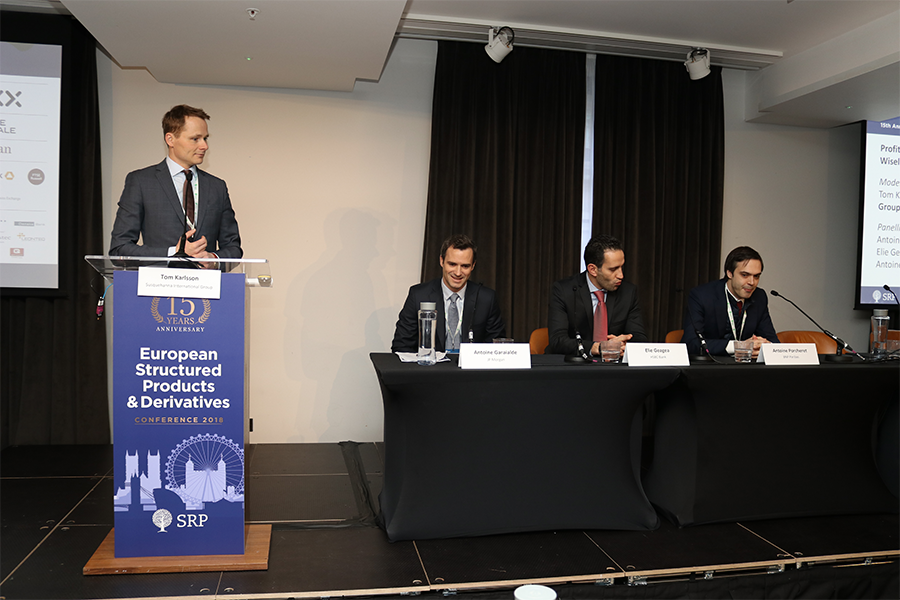The recent surge in volatility has reminded us that we all are navigating an environment where we observe a big butterfly effect and this is a lesson we should not forget, according to panelists during the Profiting from Volatility and Using Options Wisely discussion at the 15th Annual Europe Structured Products & Derivatives conference at the Etc.venues, County Hall, in London on February 9.
Despite the recent rise in volatility, market participants should not expect a high volatility regime settling in for long, considering historical trends, according to Elie Geagea (pictured), head equity derivatives structuring, HSBC. "A study on volatility over the last 100 years, shows that long periods of low volatility regimes have been observed more than 10 times and the study concludes that we have often low volatility and sometimes high volatility," said Geagea, noting that even during a very volatile period with major events such as Brexit, US elections and terrorist fears in Europe, market volatility remained low.
"The reason for the recent move in volatility was not due to any financial crisis, US credit rating changes or Asian market crash," said Gegea, adding that recent events just reminded us that volatility could be volatile. "Was it driven by some automatic algorithm? In my opinion, definitely yes."
There are a number of reasons for the low volatility regime prevailing for the last couple of years. Not only monetary policies from central banks have impacted the volatility levels but also popular short volatility strategies with a market value of US$2tr have contributed to its decrease. Nevertheless, the predominant low correlation between assets led further to volatility levels going down, discussed the panelists.

"The reason of the volatility is in fact because of us all, because of the whole investment community," said Antoine Porcheret, senior equity and derivatives strategist, Europe at BNP Paribas.
"This is just a cycle. During the financial crisis risk taking was a bit more important, people were more willing to give money to have an unlimited upside and a limited downside. This fact is the main reason for the volatility being low. Now, the investment community has turned very risk averse, at this point investors prefer to have a limited upside and an unlimited downside which basically an autocall is. This fact is the main reason for the volatility being low for so long," said Porcheret.
These factors contributed to the low levels of implied volatility, but realised volatility was also very low, according to Antoine Garaialde, executive director, equity derivatives structuring, JP Morgan. This was fueled by sectoral rotation based on elections and tax cuts, infrastructure spending, catalysts such as high employment rate and high earnings, according to Garaialde. "In terms of future volatility movements, it's natural to see volatility rising a bit due to central bank strategies and the rising correlation in the market," said Garaialde.

Deleveraging has also had an impact on the surge in volatility, according to the panelists. The short-term volatility increase last week prompted for 300 billion of risk control strategies to do a big deleveraging by buying back a huge amount of the exposure they had. "Given the move of the S&P 500 most of that deleveraging has already been done. Its impact could also be observed on the XIV products," said Garaialde.
According to Antoine Porcheret deleveraging is a self-reinforcing cycle. "The more the volatility goes down, the more equities you buy," said Porcheret. "If we go the other way around, that's a bear market ahead of us. I don't believe that could lead to a crash since the managers of these strategies don't deleverage just because you have one spike in volatility, since they deleverage only a small part of the fund," said Porcheret.
The recent volatility events already have had an impact on structured products trends. "There has been some recent interest in zero coupon plus call in USD, Eurostoxx 50 versus S&P 500 outperformance option since it is less dependent on the market, has protection on the downside and allows investors to benefit from the higher rates regime in the US," said Garaialde.
A shift from autocallable products to structures without early redemption features is also expected, according to Geagea. "However, it's early to say we have the context for a very innovative product offering. It's important to remember that we are navigating an environment with a butterfly effect and we must deliver transparent and well-governed products," said Geagea.
Looking at the future of the structured products market, the industry needs to ask itself if it has 'squeezed the lemon too much', according to Porcheret. "We have innovated in payoffs, in underlyings, but the question now is what happened with volatility," said Porcheret. "We are now at a cross road. It is a warning sign and we should maybe look into changing a bit the philosophy of investing."
Related stories:
Access to data is crucial but one must not entirely rely on it, SRP Europe
When there are many regulatory changes it can become a bit blurry, SRP Europe